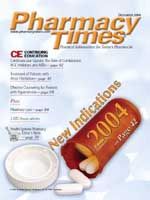Publication
Article
Pharmacy Times
Preventing and Managing Thrombosis with Anticoagulants
Author(s):
Thrombosis-dependent cardiovascular diseases include both acute and chronic syndromes (Table 1). These syndromes can be prevented and treated effectively by a variety of antithrombotic agents. Three main classes of antithrombotic agents are currently available: antiplatelet agents, which interfere with platelet activity; anticoagulants, which interfere with clotting factor synthesis and activity; and thrombolytics, which dissolve existing thrombi.
This article will focus on the anticoagulant class (Table 2) and will review available agents, indications for therapy, dosing, side effects, and monitoring. Upcoming anticoagulant agents and potential new indications will be reviewed where applicable.
Heparin
Heparin (unfractionated heparin; UH) is a glycosaminoglycan isolated from porcine and bovine lung or gut mucosa. It is composed of polysaccharide chains that contain an essential pentasaccharide sequence that binds to antithrombin III (ATIII). This action results in a conformational change in ATIII that enhances its inactivation of thrombin (IIa) and factor Xa. Other clotting factors inhibited by heparin include V, VIII, IXa, XIa, and XIIa. The molecular weight of heparin ranges from 3000 to 30,000 daltons. Only about one third of these molecules exert a pharmacologic effect. Heparin is cleared rapidly from the plasma, with an average half-life of approximately 1 hour.
The widely used test to monitor the therapeutic effect of heparin is the activated partial thromboplastin time (APTT). Several dosing nomograms have been developed to assist in attaining and maintaining heparin in the therapeutic range.1-3 For many years, the optimal therapeutic effect for the treatment of thromboembolism was defined as prolongation of the APTT to > 1.5 to 2.5 times the control value.4 Due to limitations with the above method, however, a newer approach to heparin monitoring includes targeting antifactor Xa activity for the treatment of venous thromboembolism (VTE).5,6 For the prevention of thromboembolism, heparin can be administered in doses of 5000 units subcutaneously every 8 to 12 hours.
Besides an increased risk of bleeding, heparin can cause an antibody-mediated adverse reaction known as heparininduced thrombocytopenia ( HIT ). HIT is defined as an unexplained fall in platelet count to below 50,000/??L or a drop of ??30% to 50% from baseline, with or without the development of new thrombosis.7 Platelet counts should be monitored every 2 to 3 days.8
The risk of osteoporosis increases if heparin is used for > 1 month. Contraindications and precautions include any active or recent major bleeding, surgery, trauma or stroke, uncontrolled hypertension, and previous hypersensitivity reactions. Protamine sulfate may be utilized in the treatment of heparin overdosage.
Low-Molecular-Weight Heparins
The low-molecular-weight heparins (LMWHs) are enzymatically cleaved heparin with an average molecular weight of 4000 to 6000 daltons. They are weaker inhibitors of thrombin, but they inhibit factor Xa to a similar extent. Three agents are currently available in the United States.
LMWHs have several major advantages over UH, including greater bioavailability and a longer half-life. These advantages allow for fixed weight-based dosing with no therapeutic monitoring. These agents also are associated with less HIT and less bone loss.9,10 Their indications and dosing are reviewed in Table 3.11 It is important to note that LWMHs are the preferred method of anticoagulation for the treatment of VTE in cancer patients for the first 3 to 6 months of therapy.12
The correct dosing of these agents in extremely obese patients and in those with renal impairment (with the exception of enoxaparin) remains unclear. Properties associated with one LMWH cannot be extrapolated to a different LMWH. As with UH, contraindications and precautions include any active or recent major bleeding, surgery, trauma or stroke, uncontrolled hypertension, and previous hypersensitivity reactions. Protamine sulfate may be utilized in the treatment of an LMWH overdosage.
Pentasaccharides
The pentasaccharides are synthetic derivatives of heparin with a biochemical structure similar to the essential pentasaccharide sequence necessary for heparin to bind to ATIII. Pentasaccharides allow for the inhibition of factor Xa but not thrombin, because these molecules lack the units necessary to produce thrombin inhibition by ATIII.
Fondaparinux 2.5 mg administered subcutaneously once daily is indicated for deep vein thrombosis (DVT) prophylaxis in hip and knee replacement and hip fracture surgery. It has recently been studied and approved for the treatment of acute DVT and pulmonary embolism.13 The recommended dose for these indications is as follows: 5 mg (body weight<50 kg), 7.5 mg (body weight 50-100 kg), or 10 mg (body weight > 100 kg) by subcutaneous injection once daily for at least 5 days and until a therapeutic oral anticoagulant effect is established (international normalized ratio [INR] 2.0-3.0).14 A 7.5-mg dose was expected to be available in November 2004. Although it is a heparin derivative, fondaparinux is associated with a much lower incidence of HIT. Its long half-life and greater specificity allow for fixed once-daily dosing.
The FDA recently approved safety changes to the labeling, reflecting contraindications in patients weighing<50 kg who are undergoing surgery, and in patients with severe renal impairment (creatinine clearance [CrCl]<30 mL/ min). Caution should be used in patients with moderate renal impairment (CrCl 30-50 mL/min).15 Another pentasaccharide, idraparinux, currently is undergoing phase 3 clinical trials.16
Direct Thrombin Inhibitors
Direct thrombin inhibitors (DTIs) either bind directly to thrombin in a reversible (argatroban, bivalirudin, desirudin) or irreversible (lepirudin) manner. Agents that bind irreversibly are associated with a higher incidence of bleeding. Indications for the DTIs include treatment of patients with HIT (argatroban, lepirudin); treatment of patients with angina undergoing percutaneous transluminal coronary angioplasty (bivalirudin); and prophylaxis of DVT in hip replacement surgery (desirudin).
These agents are dosed based on patients' weight and renal function as an intravenous (IV) bolus followed by a continuous infusion. References should be consulted for specific dosing guidelines. Optimal therapeutic effect is determined when a continuous IV infusion is administered in doses sufficient to prolong the APTT to > 1.5 times the control value. Contraindications and precautions include any active or recent major bleeding, cerebral aneurysm, and previous hypersensitivity reactions. More frequent adverse reactions include bleeding, pain, hypotension, nausea, and headache.
DTIs are available in the injectable form. An oral preparation, ximelagatran, however, has been studied recently for VTE prophylaxis and treatment, acute coronary syndromes, and stroke prevention in patients with atrial fibrillation. Ximelagatran has a linear dose-response relationship and can be given in fixed doses.17 Advantages of ximelagatran include fixed oral bid dosing, rapid onset of action, no therapeutic monitoring, and no known drug or dietary interactions. Potential limitations include no dosing recommendations for renal impairment, no antidote for over-anticoagulation, and inability to monitor for therapeutic effectiveness.
On September 10, 2004, the FDA advisory committee recommended against approval of this agent for short- and longterm use, citing safety concerns due to the elevation of serum transaminases and increased risk of myocardial infarction.18 On October 8, 2004, the manufacturer (Astra-Zeneca) announced that the FDA did not grant approval.
Vitamin K Antagonists
Vitamin K antagonists (VKAs) interfere with clotting factor synthesis by inhibiting the regeneration of vitamin K1 epoxide in a dose-dependent fashion. Therapeutic doses decrease vitamin K-dependent clotting factors (II, VII, IX, X, proteins C and S) by 30% to 50%. Warfarin is the oral VKA available in the United States. Its duration of action is 3 to 5 days, and it does not reach its antithrombotic effect until thrombin is inhibited (~4-5 days). It is highly protein bound and metabolized in the liver and kidney, making it subject to many drug and disease state interactions. Warfarin also is prone to dietary interactions with foods containing high amounts of vitamin K.
Monitoring of the INR is routinely required to ensure therapeutic effects. Dosing varies, based on the patients' individual response and the INR. The INR target range for the majority of patients is 2.0 to 3.0, with a higher range of 2.5 to 3.5 for most patients with mechanical heart valves.19 The most commonly reported adverse event associated with warfarin therapy is bleeding. The American College of Chest Physicians makes specific management recommendations for the over-anticoagulated patient.20 These suggestions include omitting warfarin and the use of oral or IV vitamin K.
Conclusion
The future of anticoagulant therapy will bring new and more specific antithrombotic agents that will not require intense therapeutic monitoring. Various combination therapies with other antithrombotic agents will become more prevalent in the treatment and prevention of thrombosis. Bleeding is the main complication of all antithrombotic agents. Pharmacists can play a vital role in providing management services to patients needing current and future antithrombotic therapy to ensure safety and efficacy.
Dr. Singla is an assistant professor of pharmacy practice at Midwestern University College of Pharmacy??Glendale, Glendale, Ariz.
For a list of references, send a stamped, self-addressed envelope to: References Department, Attn. A. Stahl, Pharmacy Times, 241 Forsgate Drive, Jamesburg, NJ 08831; or send an e-mail request to: [email protected].

Newsletter
Stay informed on drug updates, treatment guidelines, and pharmacy practice trends—subscribe to Pharmacy Times for weekly clinical insights.






